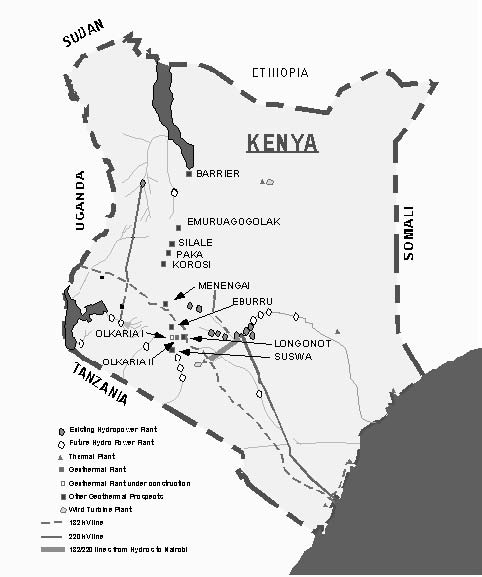National Energy Grid
|
 |
|
Full Size Map National Electricity Transmission Grid of Kenya (57 kb) |
GRID SUMMARY
The electric power sector in Kenya relies largely on renewable energy sources such as hydro power and geothermal, with the supplement of imported fossil fuels to meet the increasing demand of electricity. In 2008, total generation reached 6,460 million kilowatt hours (MkWhs), comprising its main energy sources from hydroelectric power (50%), oil (33%) and geothermal (16%). A hydro-led power sector frustrated Kenya with the production declined of 9% due to drought. Oil-fired power plants play an auxiliary role and increased the generation by 23% from 2007 to fill in the shortage of hydroelectric power. Increasing dependency on imported oils may raise electricity prices and affect other economic activities negatively. Geothermal is gaining attention with the potential of 4000 MW capacities unexploited in Kenya. To secure the reliable supply of utilities, Kenya plans to build more power plants with the total capacity of more than 2000 MW from the variety of energy sources including geothermal, hydro, wind, coal, and diesel by 2015.
National annual electricity retail sales amounted to 4964 MkWhs in 2007 and the steady growth averaged 5.7% for the last 6 years. Such increasing demand is led by industrial and commercial sectors (71%) followed by households (23%). However, electricity serves only about 15% of households including half of urban households and 4 % of rural residences. Urban households use electricity and kerosene for lighting, while dominant rural dwellers illuminate rooms with kerosene lamps. Extending grids to those who have no access to electricity has been a major policy. The networks are extended across the southern part of Kenya from coastal to western areas through a central capital, totaling the length 41,000km in 2008. The lines also connect neighboring countries including Uganda and Tanzania to trade the bulk of power and will be further interconnected with Ethiopia.
Reform of the power sector which commenced in the early 1990s has progressed to promote its efficiency. The Electric Power Act in 1997 and the Energy Act in 2006 accelerated the reform by creating an autonomous regulatory body, unbundling electricity utilities to promote more private investment in generation and reviewing tariffs to improve the financial performance of power companies. Electricity prices in 2009 averaged USD 8.6 cents per kWh and are relatively cheaper than those in US (10.34 cents per kWhs). The power utilities of generation, transmission and distribution are separately managed by three different state companies. Four Independent Power Producers (IPPs) and an Emergency Power Producer (EPP) supports generation mainly through thermal plants, accounting for 20% of total power generated. The government promulgated an ambitious target to connect one million households within five years, so more public and private investments are expected to develop reliable and affordable supply capacities in order to achieve the goal.